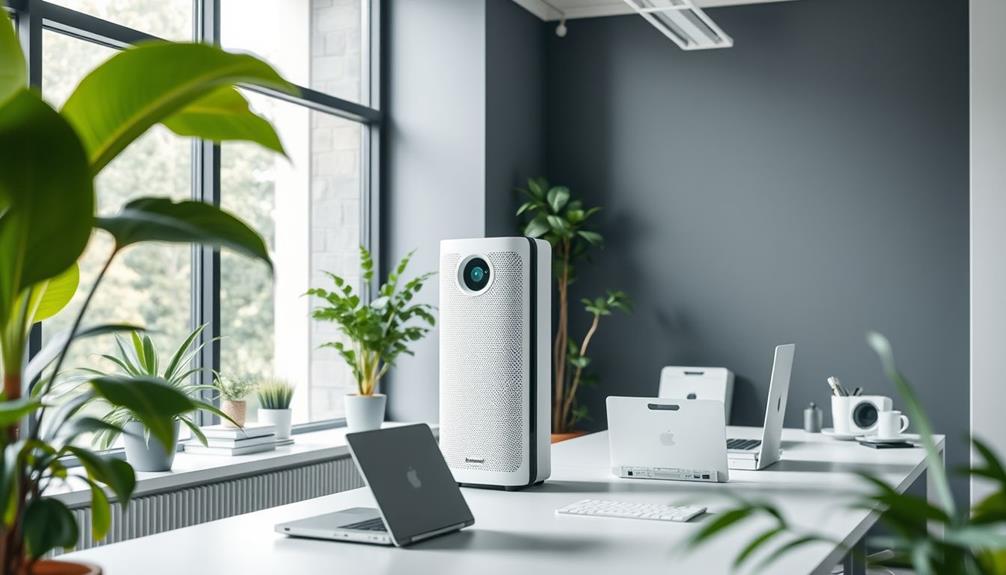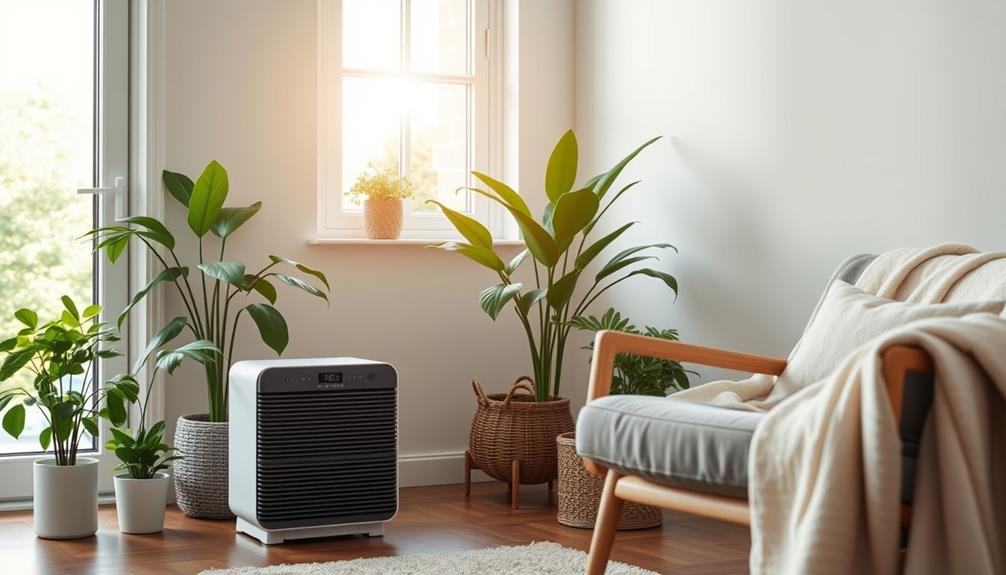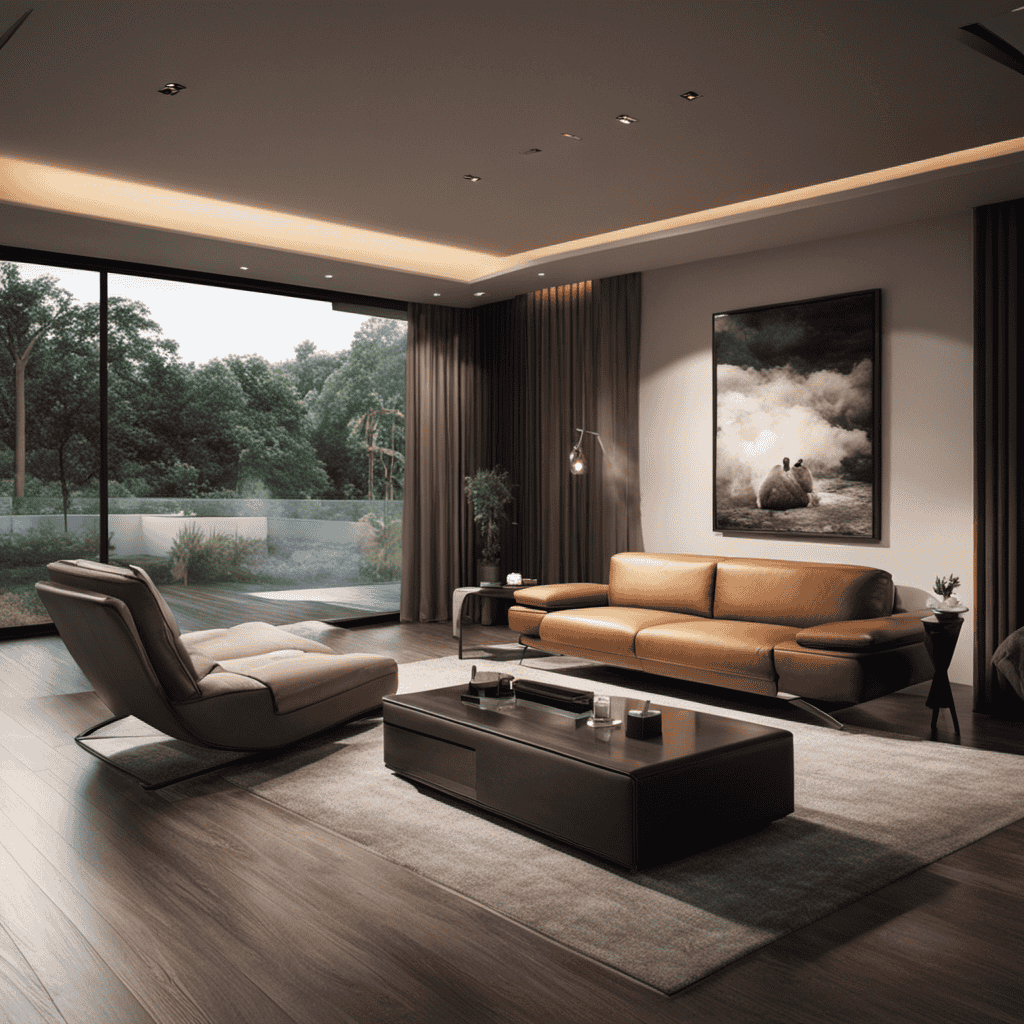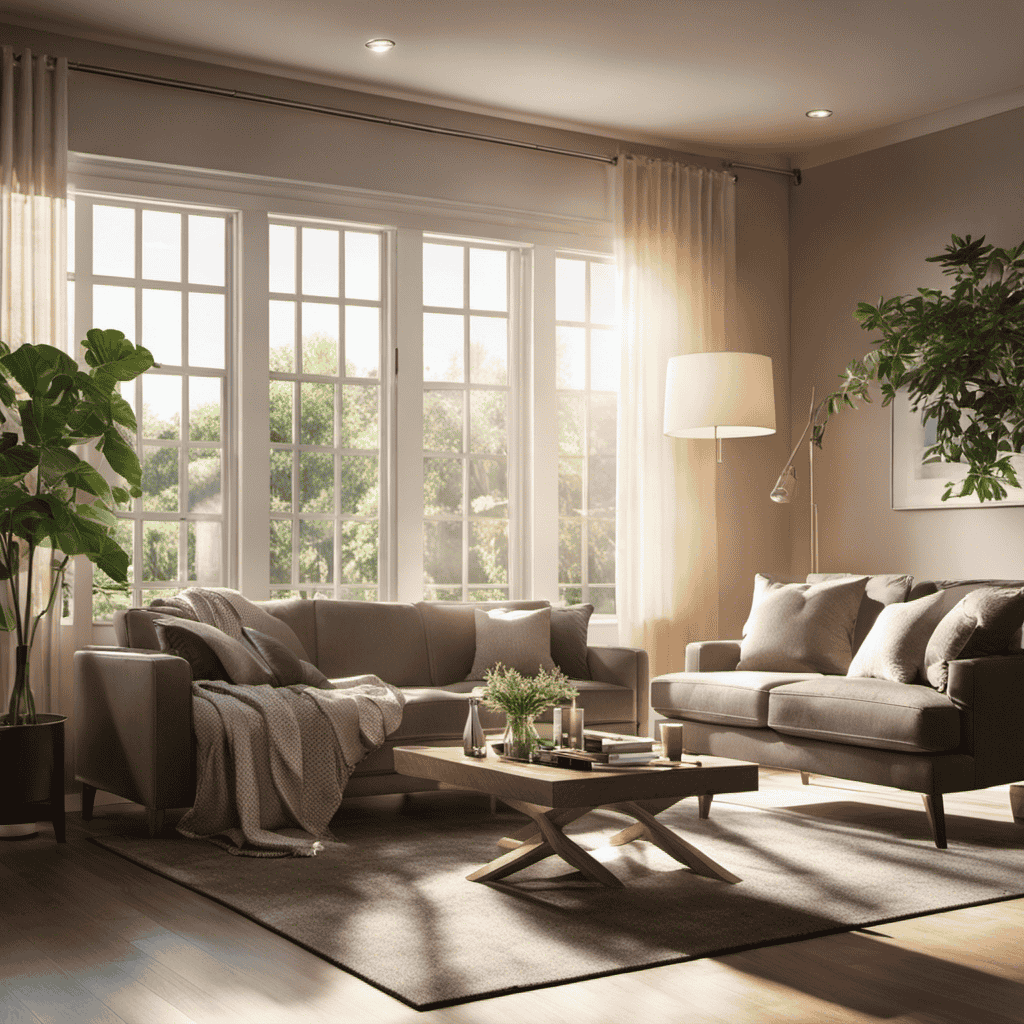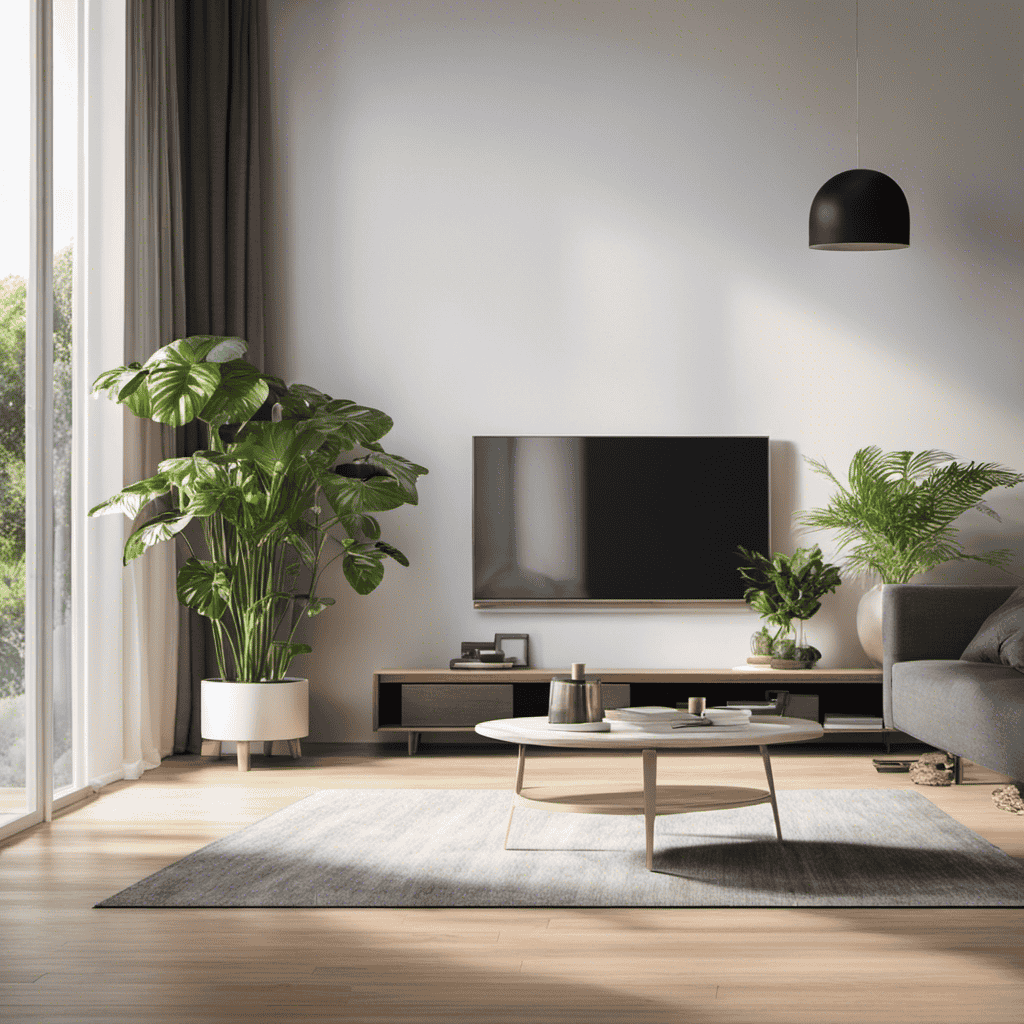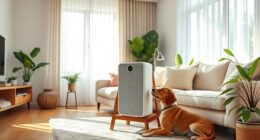Choosing an air purifier for your office is essential for improving air quality and productivity. Start by measuring your workspace to select a unit with a Clean Air Delivery Rate (CADR) suitable for that size. Look for HEPA filters to capture allergens and activated carbon filters for odors. Make sure the noise level stays below 50 decibels to maintain a conducive environment. Remember that regular maintenance and filter replacement are key for peak performance. Combining your air purifier with proper ventilation will enhance results further. Want to explore more about selecting the perfect purifier? There's a lot more to reflect on!
Key Takeaways
- Measure your office space to select an air purifier with a CADR rating that matches at least two-thirds of the square footage.
- Choose air purifiers with HEPA filters for allergens and activated carbon filters for VOCs and odors to address specific air quality concerns.
- Ensure the air purifier operates at or below 50 decibels to maintain a comfortable work environment without distractions.
- Regularly replace filters and assess maintenance needs to ensure the air purifier operates efficiently and effectively.
- Integrate air purifiers with proper ventilation systems to meet air exchange guidelines and enhance overall air quality.
Importance of Air Quality
Air quality plays an essential role in your overall well-being, especially in office environments. Poor indoor air quality can lead to respiratory illnesses, fatigue, and decreased productivity. In fact, 57% of offices report symptoms linked to sick building syndrome, which can markedly impact your day-to-day work life.
When air quality improves, you can experience a productivity boost of up to $6,500 per person annually. Utilizing ozone air purifiers can effectively eliminate allergens and odors, further enhancing the workspace atmosphere.
Clean air not only enhances concentration but also supports better work efficiency and overall job satisfaction. By maintaining good air quality, you can reduce sick days by as much as 35%, which ultimately contributes to a healthier workforce.
When you invest in an air purifier, you're taking a proactive step towards creating a conducive office space that fosters employee performance. Good air quality leads to a more comfortable work environment, allowing you and your colleagues to thrive.
Benefits of Air Purifiers
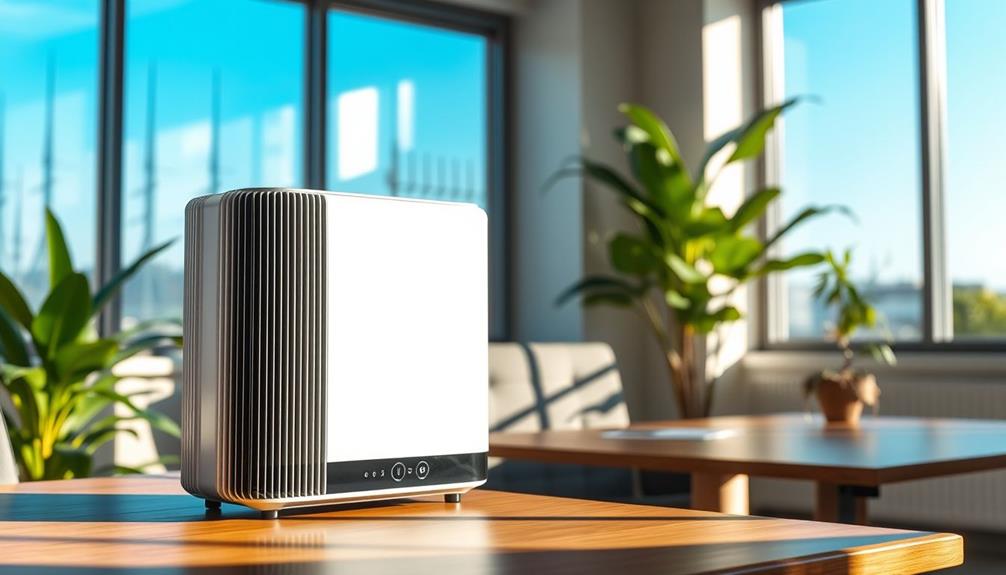
Investing in air purifiers offers numerous advantages that directly impact your workplace environment. Air purifiers include advanced technology like particulate air (HEPA) filters that effectively remove airborne particles, including PM2.5, VOCs, and even bacteria and viruses.
By improving air purification, you can greatly enhance indoor air quality, reducing pollutants linked to respiratory issues and sick building syndrome, which affects 57% of offices. Moreover, a holistic lifestyle approach, such as incorporating regular physical activity, can additionally support overall well-being in the workplace, leading to improved health outcomes mindful eating practices.
The benefits don't stop there. Research shows that better air quality can boost workplace productivity by up to $6,500 per person annually. Additionally, installing air purifiers can decrease sick days by 35%, minimizing illness-related absences among your team.
With cleaner air, employees often experience greater satisfaction and comfort, fostering a more conducive work environment.
As you create an office that prioritizes health and well-being, you're not just enhancing productivity but also nurturing a happier workforce.
To conclude, investing in air purifiers can transform your workspace into a healthier, more productive haven, benefiting both your employees and your organization as a whole.
How Air Purifiers Work
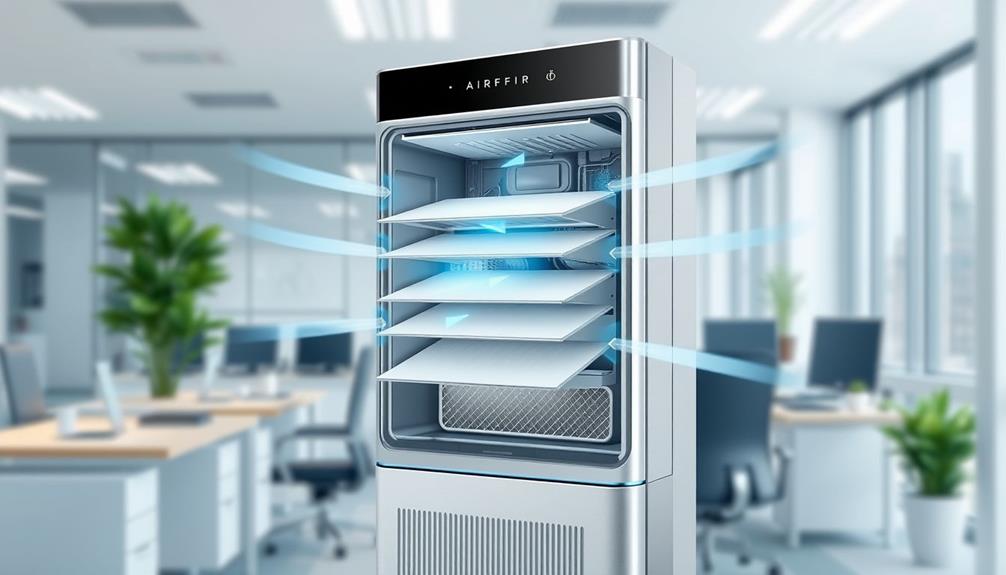
Air purifiers use various filtration mechanisms to clean the air in your space.
For instance, they can help create a serene atmosphere similar to what you might find in a modern farmhouse bedroom by removing allergens and pollutants.
You'll find that mechanical filters like HEPA capture tiny particles, while activated carbon filters tackle odors and VOCs.
Understanding these technologies and the factors affecting their performance can help you choose the right purifier for your needs.
Filtration Mechanisms Explained
When it comes to improving indoor air quality, understanding how air purifiers work is essential. Air purifiers operate by using a fan to draw in contaminated air, which then passes through various filters designed to capture specific pollutants.
One of the most effective options is HEPA filters, which trap 99.97% of particles that are 0.3 microns or larger, making them great for removing allergens like pollen and pet dander. Additionally, just as home security systems can enhance safety, ensuring clean air in your workspace promotes overall well-being and productivity enhancing overall well-being.
Activated carbon filters play a vital role as well; they absorb volatile organic compounds (VOCs) and odors, targeting gases that mechanical filters can't capture.
For an added layer of air hygiene, UV filters use ultraviolet light to kill airborne microorganisms such as bacteria and viruses when paired with particulate filters.
While ozone generators can oxidize pollutants to remove odors and smoke, use them cautiously, as inhaling ozone can pose health risks.
Performance Variability Factors
Numerous factors can impact how effectively your air purifier works in improving indoor air quality. The Clean Air Delivery Rate (CADR) is a key metric to evaluate; it measures how quickly the air purifier can filter pollutants from the air. For an office air purifier, a higher CADR rating means better performance, especially in larger spaces.
Similar to how a self-cleaning mechanism in vacuums reduces maintenance needs, efficient air purifiers can help minimize upkeep by maintaining ideal performance.
Different filters play a essential role in air purifier uses. HEPA filters target airborne particles, activated carbon filters tackle odors and gases, while UV filters can eliminate bacteria and viruses. The type of pollutants you're dealing with will determine which filters you need.
Additionally, the size of the room and the height of the ceilings affect how well the air purifier can circulate clean air.
Regular filter replacement is critical; clogged or dirty filters can greatly reduce your unit's efficiency, leading to poor air quality.
Key Features to Consider
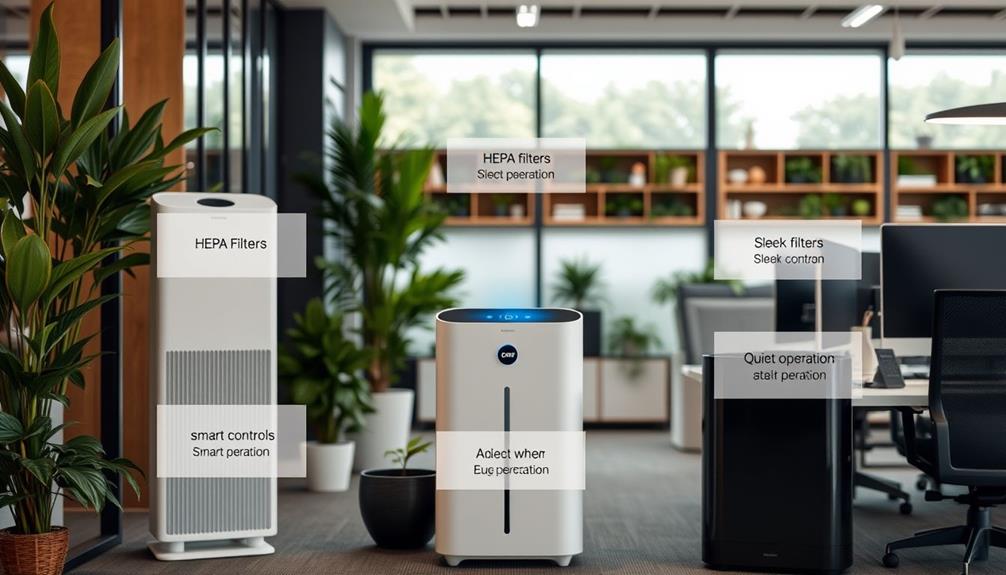
Selecting the right air purifier can greatly enhance your indoor air quality, fostering a healthier workspace. When evaluating office air purifiers, start with the Clean Air Delivery Rate (CADR) rating. Aim for a CADR that's at least two-thirds of your room's square footage to guarantee adequate air cleaning performance.
Additionally, consider how air purifiers can contribute to a cleaner environment, similar to the key factors in choosing a home cleaning service, as both focus on improving overall cleanliness and health.
Next, consider the filter type. HEPA filters are essential for capturing allergens and fine particles, while activated carbon filters help eliminate gases and odors commonly found in office settings.
Don't overlook noise levels; choose models with noise levels below 50 decibels to maintain a productive work environment without distractions.
Energy efficiency is another key feature. Look for ENERGY STAR certified models, which are at least 27% more energy-efficient than standard options, lowering both operational costs and your environmental footprint.
Lastly, think about size and placement. Confirm the air purifier is appropriately sized for your office space, taking into account both floor area and ceiling height, to maximize airflow and purification effectiveness.
Steps to Choose an Air Purifier
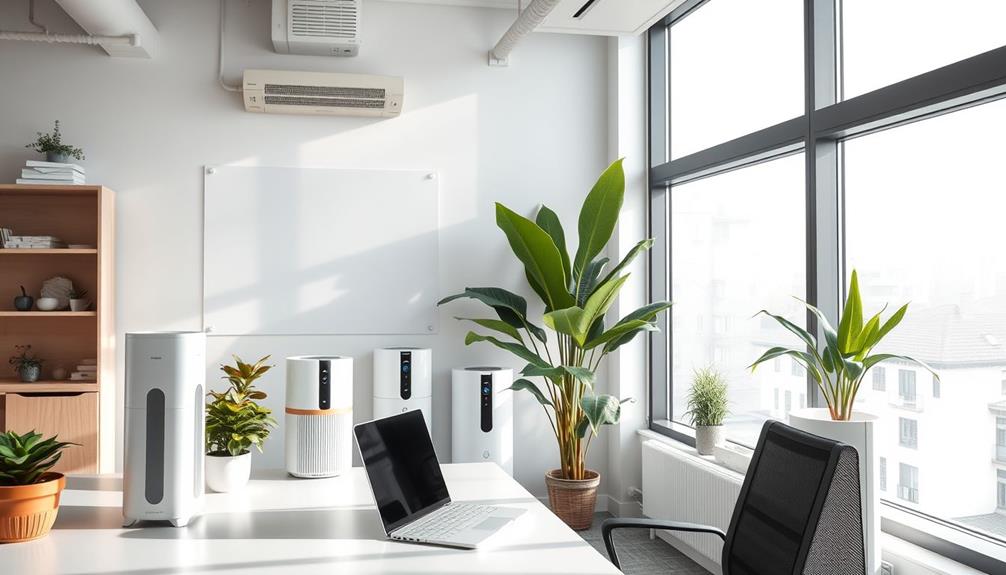
Choosing the right air purifier involves a few straightforward steps that guarantee you get the most suitable model for your office needs.
Start by measuring your office space's square footage and volume. This will help you choose a purifier that can handle at least double the calculated volume for effective air exchange.
Additionally, consider how environmental factors, such as proper disposal practices, might affect your office air quality, especially if there are sources of pollutants nearby.
Next, review the Clean Air Delivery Rate (CADR) ratings. Aim for a unit with a CADR that matches your office size; higher ratings assure better performance in removing dust, smoke, and pollen.
Consider the type of filters your air purifier will use. HEPA filters are essential for trapping allergens, while activated carbon filters effectively eliminate odors and gases.
Make certain the chosen model addresses your specific air quality concerns.
Don't forget to evaluate the noise levels. Choose models that operate at or below 50 dB to minimize distractions.
Limitations of Air Purifiers
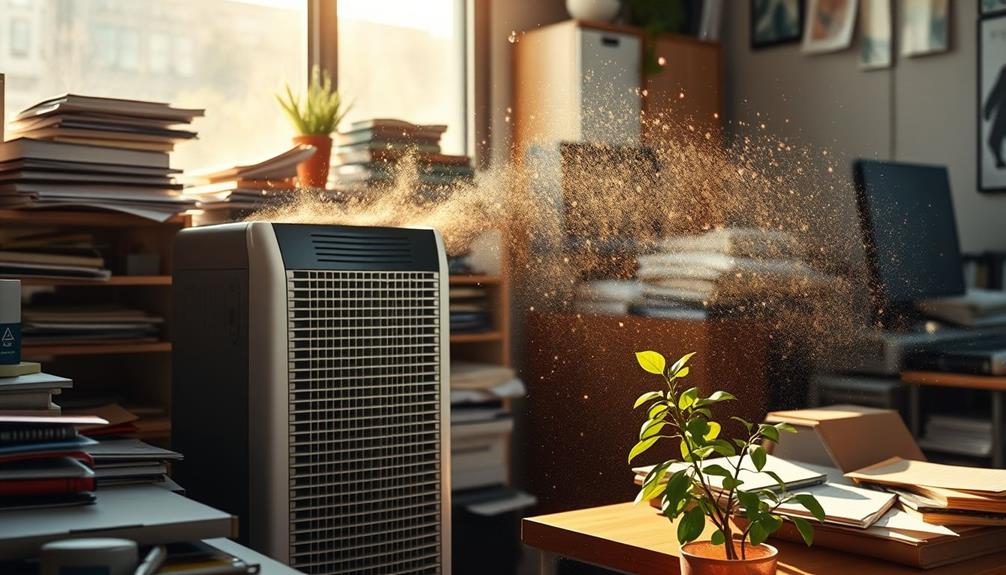
While air purifiers can improve indoor air quality, they can't replace proper ventilation, so stale air can still linger.
Additionally, neglecting HVAC maintenance can lead to compromised air quality, making it essential to guarantee your heating and cooling systems are in good shape importance of HVAC maintenance.
They also lack the ability to detect air quality issues, meaning you might need additional tools to monitor your environment.
Plus, if you're dealing with specific gases, you'll need filters designed for that purpose to guarantee effectiveness.
Cannot Replace Ventilation
Air purifiers have their place in improving indoor air quality, but they can't replace the essential role of ventilation. While purifiers can help reduce pollutants, they don't introduce fresh air into your workspace. This means that without proper ventilation, stale air can linger and pollutants may accumulate, diminishing the effectiveness of your purifiers.
For example, understanding the return policies for electronics can help you make informed decisions about purchasing devices to enhance your office environment. ASHRAE recommends that air replacement occurs at least twice per hour to maintain efficient air circulation and pollutant removal. Relying solely on air purifiers won't meet this guideline, as they can't achieve the necessary air exchange rates.
Furthermore, since purifiers lack independent detection capabilities, you won't know when additional ventilation is needed.
For the best indoor air quality, integrate purifiers with a proper ventilation system. This combination guarantees that not only are you removing particles and allergens, but you're also continuously bringing in clean air.
Limited Detection Capabilities
Even with air purifiers in place, you can't rely solely on them to manage your indoor air quality effectively. These devices have limited detection capabilities, meaning they can't identify air quality issues on their own.
When choosing an office air purifier, you need to know that without additional monitoring tools, you might miss critical pollutants. A purifier can clean the air quickly, but its effectiveness varies based on the type of contaminants present. Regular updates to your air quality strategy can enhance overall efficiency, as stated in strategies for increasing topical authority.
Moreover, air purifiers can be ineffective in environments with high gas runoff unless they're equipped with the right filters. This limitation underscores the importance of not solely depending on them for indoor air quality.
You should look for when choosing an air purifier that it complements your existing ventilation system, as stale air will persist without proper airflow.
To achieve ideal results, it's wise to purchase an air purifier alongside Indoor Air Quality (IAQ) monitors. This combination guarantees that you effectively tackle diverse air quality challenges while maximizing the benefits of your air purifier.
Specific Filter Requirements
Choosing the right air purifier involves understanding specific filter requirements, as not all filters are created equal.
While air purifiers can help reduce pollutants, they can't solve all indoor air quality issues on their own. To guarantee you're choosing the best option, consider the following:
- High-Efficiency Particulate Air (HEPA) Filters: Ideal for trapping small particles like dust and allergens.
- Activated Carbon Filters: Effective at removing odors and volatile organic compounds (VOCs).
- Pre-filters: Capture larger particles, extending the life of the main filter.
- UV-C Light: Some models offer UV-C technology to kill bacteria and viruses.
- Gas Emission Compatibility: Confirm the purifier is suited for environments with high gas emissions.
Conclusion
To sum up, investing in an air purifier for your office can greatly enhance your workspace's air quality, leading to better health and productivity. For instance, a company in a busy urban area noticed a 30% decrease in employee sick days after installing high-efficiency particulate air (HEPA) purifiers. By choosing the right model and considering key features, you can create a cleaner, healthier environment that benefits everyone. Don't underestimate the power of fresh air in your daily work life!
